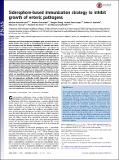| dc.contributor.author | Sassone-Corsi, Martina | |
| dc.contributor.author | Perez-Lopez, Araceli | |
| dc.contributor.author | Edwards, Robert A. | |
| dc.contributor.author | George, Michael D. | |
| dc.contributor.author | Raffatellu, Manuela | |
| dc.contributor.author | Chairatana, Phoom | |
| dc.contributor.author | Zheng, Tengfei | |
| dc.contributor.author | Nolan, Elizabeth Marie | |
| dc.date.accessioned | 2018-02-02T16:43:28Z | |
| dc.date.available | 2018-02-02T16:43:28Z | |
| dc.date.issued | 2016-11 | |
| dc.date.submitted | 2016-04 | |
| dc.identifier.issn | 0027-8424 | |
| dc.identifier.issn | 1091-6490 | |
| dc.identifier.uri | http://hdl.handle.net/1721.1/113395 | |
| dc.description.abstract | Infections with Gram-negative pathogens pose a serious threat to public health. This scenario is exacerbated by increases in antibiotic resistance and the limited availability of vaccines and therapeutic tools to combat these infections. Here, we report an immunization approach that targets siderophores, which are small molecules exported by enteric Gram-negative pathogens to acquire iron, an essential nutrient, in the host. Because siderophores are nonimmunogenic, we designed and synthesized conjugates of a native siderophore and the immunogenic carrier protein cholera toxin subunit B (CTB). Mice immunized with the CTB-siderophore conjugate developed anti-siderophore antibodies in the gut mucosa, and whenmice were infected with the enteric pathogen Salmonella, they exhibited reduced intestinal colonization and reduced systemic dissemination of the pathogen. Moreover, analysis of the gut microbiota revealed that reduction of Salmonella colonization in the inflamed gut was accompanied by expansion of Lactobacillus spp., which are beneficial commensal organisms that thrive in similar locales as Enterobacteriaceae. Collectively, our results demonstrate that anti-siderophore antibodies inhibit Salmonella colonization. Because siderophore-mediated iron acquisition is a virulence trait shared by many bacterial and fungal pathogens, blocking microbial iron acquisition by siderophore-based immunization or other siderophoretargeted approaches may represent a novel strategy to prevent and ameliorate a broad range of infections. Keyword: siderophore; immunization; iron; Salmonella; microbiota | en_US |
| dc.publisher | National Academy of Sciences (U.S.) | en_US |
| dc.relation.isversionof | http://dx.doi.org/10.1073/PNAS.1606290113 | en_US |
| dc.rights | Article is made available in accordance with the publisher's policy and may be subject to US copyright law. Please refer to the publisher's site for terms of use. | en_US |
| dc.source | PNAS | en_US |
| dc.title | Siderophore-based immunization strategy to inhibit growth of enteric pathogens | en_US |
| dc.type | Article | en_US |
| dc.identifier.citation | Sassone-Corsi, Martina et al. “Siderophore-Based Immunization Strategy to Inhibit Growth of Enteric Pathogens.” Proceedings of the National Academy of Sciences 113, 47 (November 2016): 13462–13467 © 2016 National Academy of Sciences | en_US |
| dc.contributor.department | Massachusetts Institute of Technology. Department of Chemistry | en_US |
| dc.contributor.mitauthor | Chairatana, Phoom | |
| dc.contributor.mitauthor | Zheng, Tengfei | |
| dc.contributor.mitauthor | Nolan, Elizabeth Marie | |
| dc.relation.journal | Proceedings of the National Academy of Sciences | en_US |
| dc.eprint.version | Final published version | en_US |
| dc.type.uri | http://purl.org/eprint/type/JournalArticle | en_US |
| eprint.status | http://purl.org/eprint/status/PeerReviewed | en_US |
| dc.date.updated | 2018-02-01T14:16:19Z | |
| dspace.orderedauthors | Sassone-Corsi, Martina; Chairatana, Phoom; Zheng, Tengfei; Perez-Lopez, Araceli; Edwards, Robert A.; George, Michael D.; Nolan, Elizabeth M.; Raffatellu, Manuela | en_US |
| dspace.embargo.terms | N | en_US |
| dc.identifier.orcid | https://orcid.org/0000-0002-5356-3638 | |
| dc.identifier.orcid | https://orcid.org/0000-0002-6153-8803 | |
| mit.license | PUBLISHER_POLICY | en_US |
